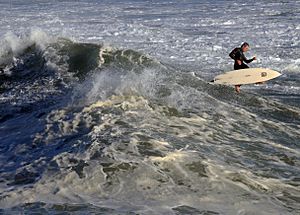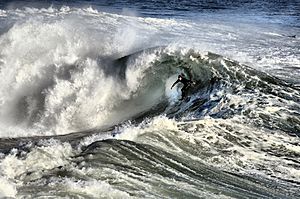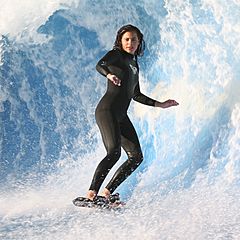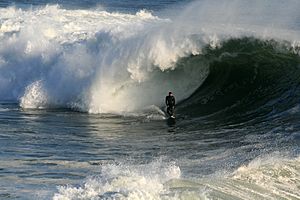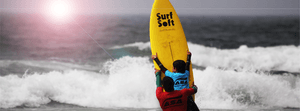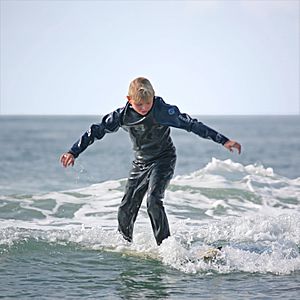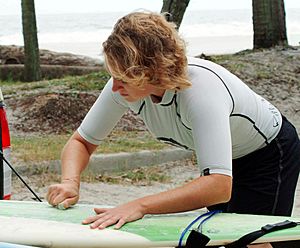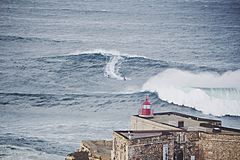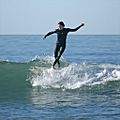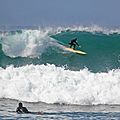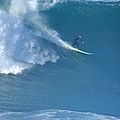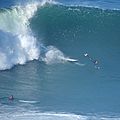Surfing facts for kids
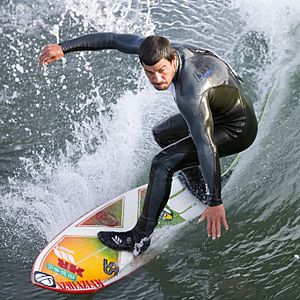
Dustin Ray surfing at the Cayucos Pier, Cayucos, California
|
|
| Highest governing body | World Surf League (WSL), International Surfing Association (ISA) |
|---|---|
| Characteristics | |
| Mixed-sex | Yes, separate competitions |
| Presence | |
| Country or region | Worldwide |
| Olympic | Will debut in 2020 |
- Surfing is also a verb meaning "To browse the World Wide Web"
Surfing is a water sport done in the ocean or sea. The surfer uses their surfboard to catch a wave and ride in towards the shore.
Surfing was invented by the Polynesians at least 4000 years ago. It has become a popular sport among both men and women of all ages. With lifestyles and regimens freer than those of most sports, surfers comprise a unique culture. Though surfing is practiced in many other Pacific nations, its center remains Hawaii, where many rounds of the international surfing championships (the ASP) are held annually. Surfing is popular in Australia, the US, and Northern Europe.
Contents
Origins and history
For hundreds of years, surfing was a central part of ancient Polynesian culture. Surfing may have first been observed by British explorers at Tahiti in 1767. Samuel Wallis and the crew members of HMS Dolphin were the first Britons to visit the island in June of that year. Another candidate is the botanist Joseph Banks being part of the first voyage of James Cook on HMS Endeavour, who arrived on Tahiti on 10 April 1769. Lieutenant James King was the first person to write about the art of surfing on Hawaii when he was completing the journals of Captain James Cook upon Cook's death in 1779.
When Mark Twain visited Hawaii in 1866 he wrote,
In one place we came upon a large company of naked natives, of both sexes and all ages, amusing themselves with the national pastime of surf-bathing.
References to surf riding on planks and single canoe hulls are also verified for pre-contact Samoa, where surfing was called fa'ase'e or se'egalu (see Augustin Krämer, The Samoa Islands), and Tonga, far pre-dating the practice of surfing by Hawaiians and eastern Polynesians by over a thousand years.
In July 1885, three teenage Hawaiian princes took a break from their boarding school, St. Mathew's Hall in San Mateo, and came to cool off in Santa Cruz, California. There, David Kawānanakoa, Edward Keliʻiahonui and Jonah Kūhiō Kalanianaʻole surfed the mouth of the San Lorenzo River on custom-shaped redwood boards, according to surf historians Kim Stoner and Geoff Dunn. In 1890 the pioneer in agricultural education John Wrightson reputedly became the first British surfer when instructed by two Hawaiian students at his college.
George Freeth (8 November 1883 – 7 April 1919) is often credited as being the "Father of Modern Surfing". He is thought to have been the first modern surfer.
In 1907, the eclectic interests of the land baron Henry E. Huntington brought the ancient art of surfing to the California coast. While on vacation, Huntington had seen Hawaiian boys surfing the island waves. Looking for a way to entice visitors to the area of Redondo Beach, where he had heavily invested in real estate, he hired a young Hawaiian to ride surfboards. George Freeth decided to revive the art of surfing, but had little success with the huge 500 cm (16 ft) hardwood boards that were popular at that time. When he cut them in half to make them more manageable, he created the original "Long board", which made him the talk of the islands. To the delight of visitors, Freeth exhibited his surfing skills twice a day in front of the Hotel Redondo. Another native Hawaiian, Duke Kahanamoku, spread surfing to both the U.S. and Australia, riding the waves after displaying the swimming prowess that won him Olympic gold medals in 1912 and 1920.
In 1975, a professional tour started. That year Margo Oberg became the first female professional surfer.
Surf waves
Swell is generated when the wind blows consistently over a large area of open water, called the wind's fetch. The size of a swell is determined by the strength of the wind and the length of its fetch and duration. Because of this, the surf tends to be larger and more prevalent on coastlines exposed to large expanses of ocean traversed by intense low pressure systems.
Local wind conditions affect wave quality since the surface of a wave can become choppy in blustery conditions. Ideal conditions include a light to moderate "offshore" wind, because it blows into the front of the wave, making it a "barrel" or "tube" wave. Waves are Left handed and Right Handed depending upon the breaking formation of the wave.
Waves are generally recognized by the surfaces over which they break. For example, there are beach breaks, reef breaks and point breaks.
The most important influence on wave shape is the topography of the seabed directly behind and immediately beneath the breaking wave. The contours of the reef or bar front become stretched by diffraction. Each break is different since each location's underwater topography is unique. At beach breaks, sandbanks change shape from week to week. Surf forecasting is aided by advances in information technology. Mathematical modeling graphically depicts the size and direction of swells around the globe.
Swell regularity varies across the globe and throughout the year. During winter, heavy swells are generated in the mid-latitudes, when the North and South polar fronts shift toward the Equator. The predominantly Westerly winds generate swells that advance Eastward, so waves tend to be largest on West coasts during winter months. However, an endless train of mid-latitude cyclones cause the isobars to become undulated, redirecting swells at regular intervals toward the tropics.
East coasts also receive heavy winter swells when low-pressure cells form in the sub-tropics, where slow moving highs inhibit their movement. These lows produce a shorter fetch than polar fronts, however, they can still generate heavy swells since their slower movement increases the duration of a particular wind direction. The variables of fetch and duration both influence how long wind acts over a wave as it travels since a wave reaching the end of a fetch behaves as if the wind died.
During summer, heavy swells are generated when cyclones form in the tropics. Tropical cyclones form over warm seas, so their occurrence is influenced by El Niño & La Niña cycles. Their movements are unpredictable.
Surf travel and some surf camps offer surfers access to remote, tropical locations, where tradewinds ensure offshore conditions. Since winter swells are generated by mid-latitude cyclones, their regularity coincides with the passage of these lows. Swells arrive in pulses, each lasting for a couple of days, with a few days between each swell.
The availability of free model data from the NOAA has allowed the creation of several surf forecasting websites.
Wave intensity
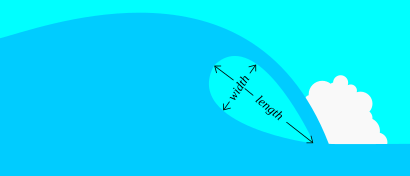
Tube shape is defined by length to width ratio. A perfectly cylindrical vortex has a ratio of 1:1. Other forms include:
- Square: <1:1
- Round: 1-2:1
- Almond: >2:1
Tube speed is defined by angle of peel line.
- Fast: 30°
- Medium: 45°
- Slow: 60°
| Fast | Medium | Slow | |
|---|---|---|---|
| Square | The Cobra | Teahupoo | Shark Island |
| Round | Speedies, Gnaraloo | Banzai Pipeline | |
| Almond | Lagundri Bay, Superbank | Jeffreys Bay, Bells Beach | Angourie Point |
Artificial reefs
The value of good surf in attracting surf tourism has prompted the construction of artificial reefs and sand bars. Artificial surfing reefs can be built with durable sandbags or concrete, and resemble a submerged breakwater. These artificial reefs not only provide a surfing location, but also dissipate wave energy and shelter the coastline from erosion. Ships such as Seli 1 that have accidentally stranded on sandy bottoms, can create sandbanks that give rise to good waves.
An artificial reef known as Chevron Reef was constructed in El Segundo, California in hopes of creating a new surfing area. However, the reef failed to produce any quality waves and was removed in 2008. In Kovalam, South West India, an artificial reef has, however, successfully provided the local community with a quality lefthander, stabilized coastal soil erosion, and provided good habitat for marine life. ASR Ltd., a New Zealand-based company, constructed the Kovalam reef and is working on another reef in Boscombe, England.
Artificial waves
Even with artificial reefs in place, a tourist's vacation time may coincide with a "flat spell", when no waves are available. Completely artificial Wave pools aim to solve that problem by controlling all the elements that go into creating perfect surf, however there are only a handful of wave pools that can simulate good surfing waves, owing primarily to construction and operation costs and potential liability. Most wave pools generate waves that are too small and lack the power necessary to surf. The Seagaia Ocean Dome, located in Miyazaki, Japan, was an example of a surfable wave pool. Able to generate waves with up to 3 m (10 ft) faces, the specialized pump held water in 20 vertical tanks positioned along the back edge of the pool. This allowed the waves to be directed as they approach the artificial sea floor. Lefts, Rights, and A-frames could be directed from this pump design providing for rippable surf and barrel rides. The Ocean Dome cost about $2 billion to build and was expensive to maintain. The Ocean Dome was closed in 2007. In England, construction is nearing completion on the Wave, situated near Bristol, which will enable people unable to get to the coast to enjoy the waves in a controlled environment, set in the heart of nature.
There are two main types of artificial waves that exist today. One being artificial or stationary waves which simulate a moving, breaking wave by pumping a layer of water against a smooth structure mimicking the shape of a breaking wave. Because of the velocity of the rushing water the wave and the surfer can remain stationary while the water rushes by under the surfboard. Artificial waves of this kind provide the opportunity to try surfing and learn its basics in a moderately small and controlled environment near or far from locations with natural surf.
Another artificial wave can be made through use of a wave pool. These wave pools strive to make a wave that replicates a real ocean wave more than the stationary wave does. In 2018, the first professional surfing tournament in a wave pool was held.
Maneuvers
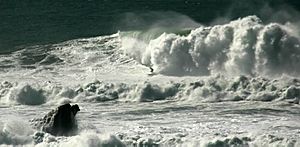
Standup surfing begins when the surfer paddles toward shore in an attempt to match the speed of the wave (the same applies whether the surfer is standup paddling, bodysurfing, boogie-boarding or using some other type of watercraft, such as a waveski or kayak). Once the wave begins to carry the surfer forward, the surfer stands up and proceeds to ride the wave. The basic idea is to position the surfboard so it is just ahead of the breaking part (whitewash) of the wave. A common problem for beginners is being able to catch the wave at all.
Surfers' skills are tested by their ability to control their board in difficult conditions, riding challenging waves, and executing maneuvers such as strong turns and cutbacks (turning board back to the breaking wave) and carving (a series of strong back-to-back maneuvers). More advanced skills include the floater (riding on top of the breaking curl of the wave), and off the lip (banking off the breaking wave). A newer addition to surfing is the progression of the air whereby a surfer propels off the wave entirely up into the air, and then successfully lands the board back on the wave.
The tube ride is considered to be the ultimate maneuver in surfing. As a wave breaks, if the conditions are ideal, the wave will break in an orderly line from the middle to the shoulder, enabling the experienced surfer to position themselves inside the wave as it is breaking. This is known as a tube ride. Viewed from the shore, the tube rider may disappear from view as the wave breaks over the rider's head. The longer the surfer remains in the tube, the more successful the ride. This is referred to as getting tubed, barrelled, shacked or pitted. Some of the world's best known waves for tube riding include Pipeline on the North shore of Oahu, Teahupoo in Tahiti and G-Land in Java. Other names for the tube include "the barrel", and "the pit".
Hanging ten and hanging five are moves usually specific to long boarding. Hanging Ten refers to having both feet on the front end of the board with all of the surfer's toes off the edge, also known as nose-riding. Hanging Five is having just one foot near the front, with five toes off the edge.
Cutback: Generating speed down the line and then turning back to reverse direction.
Floater: Suspending the board atop the wave. Very popular on small waves.
Top-Turn: Turn off the top of the wave. Sometimes used to generate speed and sometimes to shoot spray.
Airs/Aerials: These maneuvers have been becoming more and more prevalent in the sport in both competition and free surfing. An air is when the surfer can achieve enough speed and approach a certain type of section of a wave that is supposed to act as a ramp and launch the surfer above the lip line of the wave, “catching air”, and landing either in the transition of the wave or the whitewash when hitting a close-out section.
Airs can either be straight airs or rotational airs. Straight airs have minimal rotation if any, but definitely no more rotation than 90 degrees. Rotational airs require a rotation of 90 degrees or more depending on the level of the surfer.
Types of rotations:
- 180 degrees – called an air reverse, this is when the surfer spins enough to land backwards, then reverts to their original positional with the help of the fins. This rotation can either be done frontside or backside, and can spin right or left.
- 360 degrees – this is a full rotation air or “full rotor” where the surfer lands where they started or more, as long as they do not land backwards. When this is achieved front side on a wave spinning the opposite of an air reverse is called an alley oop.
- 540 degrees – the surfer does a full rotation plus another 180 degrees, and can be inverted or spinning straight, few surfers have been able to land this air.
- Backflip – usually done with a double grab, this hard to land air is made for elite level surfers.
- Rodeo flip – usually done backside, it is a backflip with a 180 rotation, and is actually easier than a straight backflip.
- Grabs – a surfer can help land an aerial maneuver by grabbing the surfboard, keeping them attached to the board and keeping the board under their feet. Common types of grabs include:
- Indy – a grab on the surfers (inside rail going frontside, outside rail going backside) with their back hand.
- Slob – a grab on the surfers (inside rail going frontside, outside rail going backside) with their front hand.
- Lien – A grab on the surfers (outside rail frontside, inside rail going backside) with their front hand.
- Stalefish – A grab on the surfers (outside rail frontside, inside rail backside) with their back hand.
- Double grab – A grab on the surfers inside and outside rail, the inside rail with the back hand and the outside rail with the front hand.
Terms
The Glossary of surfing includes some of the extensive vocabulary used to describe various aspects of the sport of surfing as described in literature on the subject. In some cases terms have spread to a wider cultural use. These terms were originally coined by people who were directly involved in the sport of surfing.
Learning
Many popular surfing destinations have surf schools and surf camps that offer lessons. Surf camps for beginners and intermediates are multi-day lessons that focus on surfing fundamentals. They are designed to take new surfers and help them become proficient riders. All-inclusive surf camps offer overnight accommodations, meals, lessons and surfboards. Most surf lessons begin with instruction and a safety briefing on land, followed by instructors helping students into waves on longboards or "softboards". The softboard is considered the ideal surfboard for learning, due to the fact it is safer, and has more paddling speed and stability than shorter boards. Funboards are also a popular shape for beginners as they combine the volume and stability of the longboard with the manageable size of a smaller surfboard. New and inexperienced surfers typically learn to catch waves on softboards around the 210 to 240 cm (7 to 8 ft) funboard size. Due to the softness of the surfboard the chance of getting injured is substantially minimized.
Typical surfing instruction is best performed one-on-one, but can also be done in a group setting. The most popular surf locations offer perfect surfing conditions for beginners, as well as challenging breaks for advanced students. The ideal conditions for learning would be small waves that crumble and break softly, as opposed to the steep, fast-peeling waves desired by more experienced surfers. When available, a sandy seabed is generally safer.
Surfing can be broken into several skills: Paddling strength, Positioning to catch the wave, timing, and balance. Paddling out requires strength, but also the mastery of techniques to break through oncoming waves (duck diving, eskimo roll). Take-off positioning requires experience at predicting the wave set and where they will break. The surfer must pop up quickly as soon as the wave starts pushing the board forward. Preferred positioning on the wave is determined by experience at reading wave features including where the wave is breaking. Balance plays a crucial role in standing on a surfboard. Thus, balance training exercises are a good preparation. Practicing with a Balance board or swing boarding helps novices master the art.
The repetitive cycle of paddling, popping up, and balancing requires stamina, explosivity, and near-constant core stabilization. Having a proper warm up routine can help prevent injuries.
Equipment
Surfing can be done on various equipment, including surfboards, longboards, stand up paddle boards (SUPs), bodyboards, wave skis, skimboards, kneeboards, surf mats and macca's trays. Surfboards were originally made of solid wood and were large and heavy (often up to 370 cm (12 ft) long and having a mass of 70 kg (150 lb)). Lighter balsa wood surfboards (first made in the late 1940s and early 1950s) were a significant improvement, not only in portability, but also in increasing maneuverability.
Most modern surfboards are made of fiberglass foam (PU), with one or more wooden strips or "stringers", fiberglass cloth, and polyester resin (PE). An emerging board material is epoxy resin and Expanded Polystyrene foam (EPS) which is stronger and lighter than traditional PU/PE construction. Even newer designs incorporate materials such as carbon fiber and variable-flex composites in conjunction with fiberglass and epoxy or polyester resins. Since epoxy/EPS surfboards are generally lighter, they will float better than a traditional PU/PE board of similar size, shape and thickness. This makes them easier to paddle and faster in the water. However, a common complaint of EPS boards is that they do not provide as much feedback as a traditional PU/PE board. For this reason, many advanced surfers prefer that their surfboards be made from traditional materials.
Other equipment includes a leash (to stop the board from drifting away after a wipeout, and to prevent it from hitting other surfers), surf wax, traction pads (to keep a surfer's feet from slipping off the deck of the board), and fins (also known as skegs) which can either be permanently attached (glassed-on) or interchangeable. Sportswear designed or particularly suitable for surfing may be sold as boardwear (the term is also used in snowboarding). In warmer climates, swimsuits, surf trunks or boardshorts are worn, and occasionally rash guards; in cold water surfers can opt to wear wetsuits, boots, hoods, and gloves to protect them against lower water temperatures. A newer introduction is a rash vest with a thin layer of titanium to provide maximum warmth without compromising mobility. In recent years, there have been advancements in technology that have allowed surfers to pursue even bigger waves with added elements of safety. Big wave surfers are now experimenting with inflatable vests or colored dye packs to help decrease their odds of drowning.
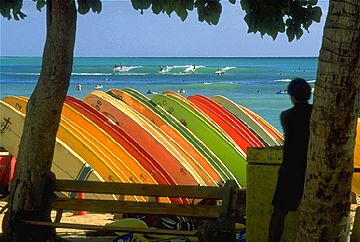
There are many different surfboard sizes, shapes, and designs in use today. Modern longboards, generally 270 to 300 cm (9 to 10 ft) in length, are reminiscent of the earliest surfboards, but now benefit from modern innovations in surfboard shaping and fin design. Competitive longboard surfers need to be competent at traditional walking manoeuvres, as well as the short-radius turns normally associated with shortboard surfing. The modern shortboard began life in the late 1960s and has evolved into today's common thruster style, defined by its three fins, usually around 180 to 210 cm (6 to 7 ft) in length. The thruster was invented by Australian shaper Simon Anderson.
Midsize boards, often called funboards, provide more maneuverability than a longboard, with more flotation than a shortboard. While many surfers find that funboards live up to their name, providing the best of both surfing modes, others are critical.
- "It is the happy medium of mediocrity," writes Steven Kotler. "Funboard riders either have nothing left to prove or lack the skills to prove anything."
There are also various niche styles, such as the Egg, a longboard-style short board targeted for people who want to ride a shortboard but need more paddle power. The Fish, a board which is typically shorter, flatter, and wider than a normal shortboard, often with a split tail (known as a swallow tail). The Fish often has two or four fins and is specifically designed for surfing smaller waves. For big waves there is the Gun, a long, thick board with a pointed nose and tail (known as a pin tail) specifically designed for big waves.
The physics of surfing
The physics of surfing involves the physical oceanographic properties of wave creation in the surf zone, the characteristics of the surfboard, and the surfer's interaction with the water and the board.
Wave formation
Ocean waves are defined as a collection of dislocated water parcels that undergo a cycle of being forced past their normal position and being restored back to their normal position. Wind caused ripples and eddies form waves that gradually gain speed and distance (fetch). Waves increase in energy and speed, and then become longer and stronger. The fully developed sea has the strongest wave action that experiences storms lasting 10-hours and creates 15 meter wave heights in the open ocean.
The waves created in the open ocean are classified as deep-water waves. Deep-water waves have no bottom interaction and the orbits of these water molecules are circular; their wavelength is short relative to water depth and the velocity decays before the reaching the bottom of the water basin. Deep waves have depths greater than ½ their wavelengths. Wind forces waves to break in the deep sea.
Deep-water waves travel to shore and become shallow water waves. Shallow water waves have depths less than ½ of their wavelength. Shallow wave's wavelengths are long relative to water depth and have elliptical orbitals. The wave velocity effects the entire water basin. The water interacts with the bottom as it approaches shore and has a drag interaction. The drag interaction pulls on the bottom of the wave, causes refraction, increases the height, decreases the celerity (or the speed of the wave form), and the top (crest) falls over. This phenomenon happens because the velocity of the top of the wave is greater than the velocity of the bottom of the wave.
The surf zone is place of convergence of multiple waves types creating complex wave patterns. A wave suitable for surfing results from maximum speeds of 5 meters per second. This speed is relative because local onshore winds can cause waves to break. In the surf zone, shallow water waves are carried by global winds to the beach and interact with local winds to make surfing waves.
Different onshore and off-shore wind patterns in the surf zone create different types of waves. Onshore winds cause random wave breaking patterns and are more suitable for experienced surfers. Light offshore winds create smoother waves, while strong direct offshore winds cause plunging or large barrel waves. Barrel waves are large because the water depth is small when the wave breaks. Thus, the breaker intensity (or force) increases, and the wave speed and height increase. Off-shore winds produce non-surfable conditions by flattening a weak swell. Weak swell is made from surface gravity forces and has long wavelengths.
Wave conditions for surfing
Surfing waves can be analyzed using the following parameters: breaking wave height, wave peel angle (α), wave breaking intensity, and wave section length. The breaking wave height has two measurements, the relative heights estimated by surfers and the exact measurements done by physical oceanographers. Measurements done by surfers were 1.36 to 2.58 times higher than the measurements done by scientists. The scientifically concluded wave heights that are physically possible to surf are 1 to 20 meters.
The wave peel angle is one of the main constituents of a potential surfing wave. Wave peel angle measures the distance between the peel-line and the line tangent to the breaking crest line. This angle controls the speed of the wave crest. The speed of the wave is an addition of the propagation velocity vector (Vw) and peel velocity vector (Vp), which results in the overall velocity of the wave (Vs).
Wave breaking intensity measures the force of the wave as it breaks, spills, or plunges (a plunging wave is termed by surfers as a "barrel wave"). Wave section length is the distance between two breaking crests in a wave set. Wave section length can be hard to measure because local winds, non-linear wave interactions, island sheltering, and swell interactions can cause multifarious wave configurations in the surf zone.
The parameters breaking wave height, wave peel angle (α), and wave breaking intensity, and wave section length are important because they are standardized by past oceanographers who researched surfing; these parameters have been used to create a guide that matches the type of wave formed and the skill level of surfer.
| Skill level | Peel angle (degrees) | Wave height (meters) | Section speed (meters/second) | Section length (meters) | General locations of waves |
|---|---|---|---|---|---|
| Beginner | 60-70 | 2.5 | 10 | 25 | Low Gradient Breaks; Atlantic Beach, Florida |
| Intermediate | 55 | 2.5 | 20 | 40 | Bells Beach; New Zealand |
| Competent | 40-50 | 3 | 20 | 40-60 | Kirra Point; Burleigh Heads |
| Top Amateur | 30 | 3 | 20 | 60 | Bingin Beach; Padang Padang Beach |
| Top World Surfer | >27 | 3 | 20 | 60 | Banzai Pipeline; Shark Island; Pipes, Encinitas |
Table 1 shows a relationship of smaller peel angles correlating with a higher skill level of surfer. Smaller wave peel angles increase the velocities of waves. A surfer must know how to react and paddle quickly to match the speed of the wave to catch it. Therefore, more experience is required to catch a low peel angle waves. More experienced surfers can handle longer section lengths, increased velocities, and higher wave heights. Different locations offer different types of surfing conditions for each skill level.
Surf breaks
A surf break is an area with an obstruction or an object that causes a wave to break. Surf breaks entail multiple scale phenomena. Wave section creation has micro-scale factors of peel angle and wave breaking intensity. The micro-scale components influence wave height and variations on wave crests. The mesoscale components of surf breaks are the ramp, platform, wedge, or ledge that may be present at a surf break. Macro-scale processes are the global winds that initially produce offshore waves. Types of surf breaks are headlands (point break), beach break, river/estuary entrance bar, reef breaks, and ledge breaks.
Headland (point break)
A headland or point break interacts with the water by causing refraction around the point or headland. The point absorbs the high frequency waves and long period waves persist, which are easier to surf. Examples of locations that have headland or point break induced surf breaks are Dunedin (New Zealand), Raglan, Malibu (California), Rincon (California), and Kirra (Australia).
Beach break
A beach break happens where waves break from offshore waves, and onshore sandbars and rips. Wave breaks happen successively at beach breaks. Example locations are Tairua and Aramoana Beach (New Zealand) and the Gold Coast (Australia).
River or estuary entrance bar
A river or estuary entrance bar creates waves from the ebb tidal delta, sediment outflow, and tidal currents. An ideal estuary entrance bar exists in Whangamata Bar, New Zealand.
Reef break
A reef break is conducive to surfing because large waves consistently break over the reef. The reef is usually made of coral, and because of this, many injuries occur while surfing reef breaks. However, the waves that are produced by reef breaks are some of the best in the world. Famous reef breaks are present in Padang Padang (Indonesia), Pipeline (Hawaii), Uluwatu (Bali), and Teahupo'o (Tahiti). When surfing a reef break, the depth of the water needs to be considered as surfboards have fins on the bottom of the board.
Ledge break
A ledge break is formed by steep rocks ledges that makes intense waves because the waves travel through deeper water then abruptly reach shallower water at the ledge. Shark Island, Australia is a location with a ledge break. Ledge breaks create difficult surfing conditions, sometimes only allowing body surfing as the only feasible way to confront the waves.
Jetties and their impacts on wave formation in the surf zone
Jetties are added to bodies of water to regulate erosion, preserve navigation channels, and make harbors. Jetties are classified into four different types and have two main controlling variables: the type of delta and the size of the jetty.
Type 1 jetty
The first classification is a type 1 jetty. This type of jetty is significantly longer than the surf zone width and the waves break at the shore end of the jetty. The effect of a Type 1 jetty is sediment accumulation in a wedge formation on the jetty. These waves are large and increase in size as they pass over the sediment wedge formation. An example of a Type 1 jetty is Mission Beach, San Diego, California. This 1000-meter jetty was installed in 1950 at the mouth of Mission Bay. The surf waves happen north of the jetty, are longer waves, and are powerful. The bathymetry of the sea bottom in Mission Bay has a wedge shape formation that causes the waves to refract as they become closer to the jetty. The waves converge constructively after they refract and increase the sizes of the waves.
Type 2 jetty
A type 2 jetty occurs in an ebb tidal delta, a delta transitioning between high and low tide. This area has shallow water, refraction, and a distinctive seabed shapes that creates large wave heights.
An example of a type 2 jetty is called "The Poles" in Atlantic Beach, Florida. Atlantic Beach is known to have flat waves, with exceptions during major storms. However, "The Poles" has larger than normal waves due to a 500-meter jetty that was installed on the south side of the St. Johns. This jetty was built to make a deep channel in the river. It formed a delta at "The Poles". This is special area because the jetty increases wave size for surfing, when comparing pre-conditions and post-conditions of the southern St. Johns River mouth area.
The wave size at "The Poles" depends on the direction of the incoming water. When easterly waters (from 55°) interact with the jetty, they create waves larger than southern waters (from 100°). When southern waves (from 100°) move toward "The Poles", one of the waves breaks north of the southern jetty and the other breaks south of the jetty. This does not allow for merging to make larger waves. Easterly waves, from 55°, converge north of the jetty and unite to make bigger waves.
Type 3 jetty
A type 3 jetty is in an ebb tidal area with an unchanging seabed that has naturally created waves. Examples of a Type 3 jetty occurs in “Southside” Tamarack, Carlsbad, California.
Type 4 jetty
A type 4 jetty is one that no longer functions nor traps sediment. The waves are created from reefs in the surf zone. A type 4 jetty can be found in Tamarack, Carlsbad, California.
Rip currents
Rip currents are fast, narrow currents that are caused by onshore transport within the surf zone and the successive return of the water seaward. The wedge bathymetry makes a convenient and consistent rip current of 5–10 meters that brings the surfers to the “take off point” then out to the beach.
Oceanographers have two theories on rip current formation. The wave interaction model assumes that two edges of waves interact, create differing wave heights, and cause longshore transport of nearshore currents. The Boundary Interaction Model assumes that the topography of the sea bottom causes nearshore circulation and longshore transport; the result of both models is a rip current.
Rip currents can be extremely strong and narrow as they extend out of the surf zone into deeper water, reaching speeds from 0.5 m/s (1.6 ft/s) and up to 2.5 m/s (8.2 ft/s), which is faster than any human can swim. The water in the jet is sediment rich, bubble rich, and moves rapidly. The rip head of the rip current has long shore movement. Rip currents are common on beaches with mild slopes that experience sizeable and frequent oceanic swell.
The vorticity and inertia of rip currents have been studied. From a model of the vorticity of a rip current done at Scripps Institute of Oceanography, it was found that a fast rip current extends away from shallow water, the vorticity of the current increases, and the width of the current decreases. This model also acknowledges that friction plays a role and waves are irregular in nature. From data from Sector-Scanning Doppler Sonar at Scripps Institute of Oceanography, it was found that rip currents in La Jolla, CA lasted several minutes, reoccurred one to four times per hour, and created a wedge with a 45° arch and a radius 200–400 meters.
On the surfboard
A longer surfboard of 300 cm (10 ft) causes more friction with the water; therefore, it will be slower than a smaller and lighter board with a length of 180 cm (6 ft). Longer boards are good for beginners who need help balancing. Smaller boards are good for more experienced surfers who want to have more control and maneuverability.
When practicing the sport of surfing, the surfer paddles out past the wave break to wait for a wave. When a surfable wave arrives, the surfer must paddle extremely fast to match the velocity of the wave so the wave can accelerate him or her.
When the surfer is at wave speed, the surfer must quickly pop up, stay low, and stay toward the front of the wave to become stable and prevent falling as the wave steepens. The acceleration is less toward the front than toward the back. The physics behind the surfing of the wave involves the horizontal acceleration force (F·sinθ) and the vertical force (F·cosθ=mg). Therefore, the surfer should lean forward to gain more speed, and lean on back foot to brake. Also, to increase the length of the ride of the wave, the surfer should travel parallel to the wave crest.
Related pages
Images for kids
-
A surfer in Oahu.
-
Surfing on the Gold Coast, Queensland (Australia)
See also
 In Spanish: Surf para niños
In Spanish: Surf para niños


